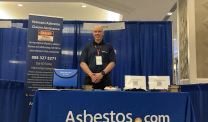Scholarship Winner Studies Asbestos, Other Public Health Hazards
Advocacy| Edited By Walter Pacheco

Kate Clancy is pursuing a master’s degree in public health and occupational health at the Colorado School of Public Health. She is the first-place winner of the Fall 2021 Asbestos.com scholarship.
My sophomore year in a mineralogy class at the University of Alaska Fairbanks opened my eyes to asbestos, its nonasbestiform analogues and life-altering diseases such as malignant mesothelioma, asbestosis and ovarian cancer.
During my time at field camp for my undergraduate degree, I vividly remember picking up a rock that looked fibrous and needle-like in nature. I knew asbestos was a mineral that formed in a specific way, but I did not know that it carried so many harmful properties.
I was told by my teacher’s assistant that the “blue asbestos” was the worst and to “stay away from that.” Upon further investigation, I realized what I was holding was the mineral wollastonite, commonly found in northern Alaska. I also learned there was evidence to suggest wollastonite fibers can be deposited into the lungs and subsequently decrease lung function.
My studies in geological engineering at UAF and environmental and occupational health training at the Colorado School of Public Health, paired with my unique field work and legal work, have laid the foundation for my interest in asbestos.
Geological engineering involves applying geologic, hydraulic and environmental knowledge to engineering applications to produce safe, long-lasting designs. I am deeply interested in the intersection of public health and geological processes and products.
Research Links Asbestos in Talc to Cancer
Since 2018, I have assisted in nationally recognized, groundbreaking trial work that linked cancer causation to asbestos and respirable elongated mineral particles (REMPs) contained in a ubiquitous baby powder made by Johnson & Johnson. My extensive geology coursework at UAF provided me with an excellent foundation from which to link the causation to asbestos present in baby powder.
In spring 2018, I joined the research team of Dr. David Egilman, a clinical professor at Brown University, as part of nationwide asbestos litigation against Johnson & Johnson. I researched geologic occurrences of asbestos in talc, cleavage fragments, short fibers and other REMPs that are not regulated by government agencies.
When I was not in class I was researching asbestos, cleavage fragments, amphibole and serpentine minerals, talc and other particles that cause adverse health effects.
In June 2018, I joined the legal team on location in St. Louis, where one of the personal injury/product liability civil cases was proceeding to trial. Egilman was the medical expert for the 22 plaintiffs who were diagnosed with ovarian cancer due to lifelong cosmetic talcum powder use.
We presented irrefutable evidence that there are asbestos and acicular mineral fragments in Johnson’s Baby Powder and Shower-to-Shower products that cause cancer.
The jury returned a $4.7 billion verdict in favor of the plaintiffs and against Johnson & Johnson. I am honored to have contributed my research on the geologic occurrences of asbestos, fibrous talc and cleavage fragments’ biopersistence to this monumental outcome.
Many Minerals Pose a Public Health Threat
While the plaintiffs’ Johnson & Johnson litigation shed light on this public health issue, further work is needed to identify and assess the adverse health outcomes of several REMPs that are not classified as asbestos.
My interest in geologic health hazards in environmental, occupational and industrial applications has expanded since the St. Louis trial. I am finding there is very little overlap between public health practice and geologic, geohazard and hydraulic characterization.
The six regulated asbestos minerals are not the only carcinogenic minerals or materials that pose a public health threat. There is toxicological and epidemiologic evidence that cleavage fragments, asbestiform and nonasbestiform zeolite minerals, high concentrations of silica and fibrous talc can cause adverse health effects.
Unfortunately, the wollastonite I picked up several summers ago is not formally regulated as a type of asbestos mineral, even though it falls within a geologic solid solution series with actinolite, a regulated asbestos mineral.
Awareness of Risks Needed
Understanding how these minerals form within the earth, what characteristics and properties contribute to carcinogenicity and where they can be found is vital for preventing cancer in environmental and occupational settings. Consumer products that may contain harmful REMPs may be identified as well.
Toxicological research is necessary to determine the effects of these minerals and their toll on the human body. Then, when the need is demonstrated, such minerals should be regulated just as federal agencies regulate asbestos.
Future work is needed to bridge the gap between geologic occurrences of asbestos/REMPs and asbestos-related diseases. Workers and consumers must also be aware of the risks of harmful particles that may contaminate their workplace, home, food or makeup.
Regulating agencies must also be informed of the risks of REMPs and seriously consider all robust epidemiologic studies that indicate how REMPs harm human health. It is paramount to identify how these respirable particles occur and recognize how they influence mesothelioma, ovarian cancer and asbestosis incidence around the world.






